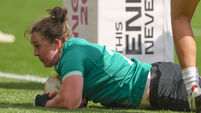Clubs at crossroads in new era
By Sunday evening, all eight qualifiers will be known and the quarter-final draw complete. Over the past three weekends we have been treated to some exhilarating rugby. This weekend will be no different.
The protracted nature of the representative season is evidenced by the fact that from Monday next, the competition enters a period of hibernation until April 10th.
Attention will shift next week to the announcement of the national squads for the forthcoming Six Nations championship. With Ireland’s opening game against the French in Paris less than three weeks away, there will be tremendous interest in the announcement of the starting 15.
In the meantime the AIB All Ireland League trundles on. In a season incorporating the World Cup, an expanded Celtic League and the Heineken Cup, the club game is struggling to survive. Attendances are at an all time low, which is a pity as the League has hosted some entertaining rugby with the best of young talent on view.
Almost unnoticed, two burning issues that will impact on the future of the game in this country are likely to be addressed this week. After years of speculation with regards to a National Stadium, the government have clarified their position on the redevelopment of Lansdowne Road.
Of equal importance for the club game is outcome of the first division clubs meeting in Dublin this evening when they vote on their vision for the future of the All Ireland League.
When the AIL was first introduced in 1991, a totally different set of circumstances prevailed in the game in Ireland. Rugby at all levels was amateur and it was recognised that in order to create a more competitive environment for players preparing for international rugby, a national competition was required.
When Cork Constitution won the inaugural title, only nine teams participated in the competition. Such was the impact of the League over the first few seasons that provincial rugby took a back seat. The attraction of representing your parish on a national stage, something that GAA players had done for centuries, now added great impetus to the club scene.
Nowhere was the desire to succeed greater than with the Munster clubs. As a result of the competitive nature fostered through the Munster Senior Cup, Munster clubs dominated on the national stage. How ironic therefore that the bottom six places in Ddivision Ttwo are presently occupied by Munster teams.
When the Heineken Cup was first introduced in 1996, the competitive nature of the AIL enabled the provinces to compete favourably with more fancied opponents from England and France. Now, as a result of the growing demands of professional rugby, the AIL is no longer the domain of the professional player. The clubs are at a crossroads.
Even within the IRFU there are diverse views with regard to the way the club game should develop. On the one hand, those in charge of the domestic game have a desire to see club rugby revert to provincially based leagues. The difficulty with this is that despite the likelihood of players being contracted to provincial squads at a younger age, a high percentage will still be nurtured and developed through the club system. Provincial leagues at all levels will inevitably lead to a further fall in standards.
This season with so many players unavailable to the provinces because of the demands of the World Cup, others were fast tracked from the club system to play in the Celtic League.
It was clear that many of these young players were under-prepared for the jump in standard. The IRFU recognise clubs need major assistance in the development of their players.
My belief is that the first division needs to continue on a national basis as a halfway house between the amateur and professional game.
Young players with aspirations to turn professional should be catered for in Division One. A reduction in the Celtic League programme would also offer the opportunity to some players, contracted to the provinces, to partake in the AIL.
Tonight the first division clubs have an opportunity of voting for their future. Under the current agreement, the AIL is due to be reduced to 14 teams by next season.
With the IRFU’s Strategic Review on the verge of completion, the clubs themselves must clarify which route they wish to adopt. In making this decision, they must display leadership and unity.
In my view a first division of 12twelve teams would be the ideal base to support the professional game. Young players who aspire to play professionally could be accommodated at this level. The IRFU could supply the proper support structures in terms of coaching, nutrition, physical conditioning and technical advice. With proper marketing and more imaginative scheduling of games, it would provide a much-needed shot in the arm for club rugby in Ireland.
It is vital that the current representatives of the first division clubs do not adopt an elitist attitude. Promotion and relegation should still be part and parcel of the overall package.
There are some indications that the Division Two and Division Three clubs wish to revert to a provincial league basis with national playoffs. This makes sense. However, progressive clubs must always have the opportunity of promotion to the national league. For too long, many clubs have hidden behind their own inadequacies and blamed the IRFU for the ills of the club game.
The Strategic Review, offered all the clubs in Ireland the opportunity of contributing to the future of the game in this country. The first Division clubs now have a clear mandate to present their vision for the future. It will be interesting to see what they come up with.
















